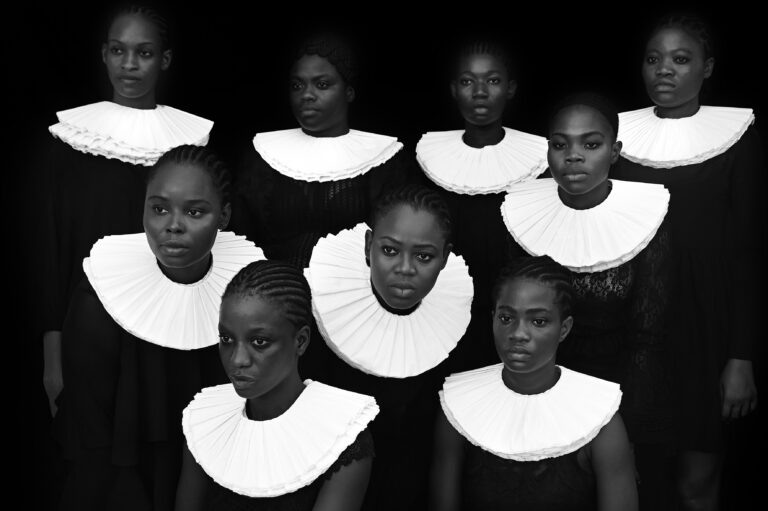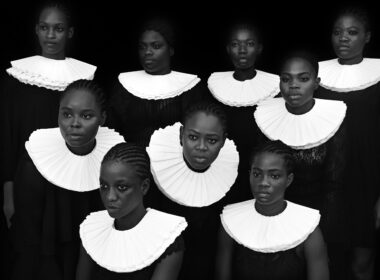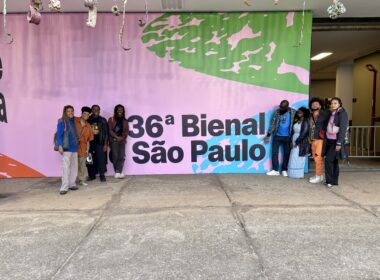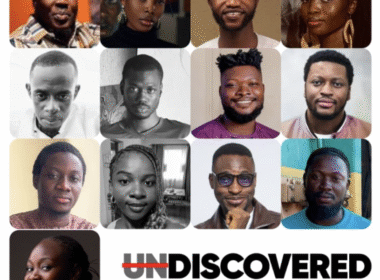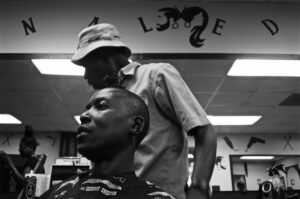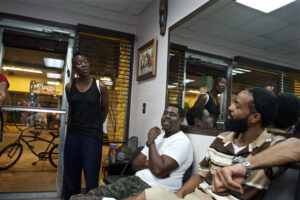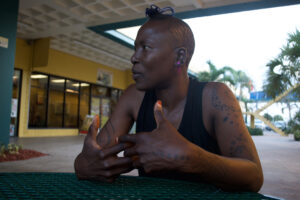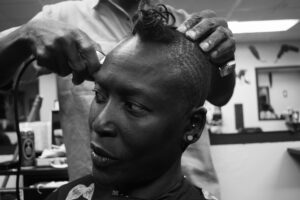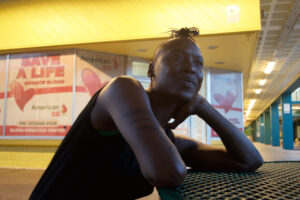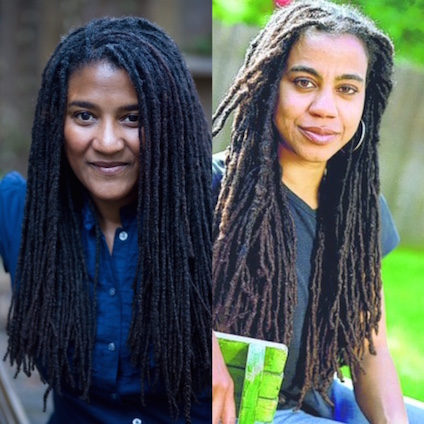Photography by Johanne Rahaman. Performance photo by Gennadi Novash.
A few month’s ago, I met dancer Nora Chipaumire at a barbershop in the 79th Street Shopping Center in Miami. Once a home to major anchor stores, this shopping plaza is a group of stores owned by small business owners from all over the world such as Korea, Columbia, the Bahamas. You can get your nails done, a hairdo, buy a complete wardrobe for your family and try cuisine from different cultures. The experience would seem like an anomaly to those outside of this inner city community. The reality is that this is the norm, a culturally diverse and cosmopolitan way of life that most people take live yet are not acutely aware of this global lifestyle. This is why it was apropos to meet Chipaumire here: she wanted a fresh haircut, and I wanted to speak to her in a community that many that look like her call home. I have to admit, I’ve watched her for years, so to see her in person was a bit a fan girl moment for me. While I kept cool when I met her, our conversation not only blew me away, but I was inspired and moved by her words and energy. I don’t often speak with people that are revolutionary off-stage as they are on. We talked for quite some time but it was this portion of the interview (Basically, it was an informal masterclass ) was filled with cultural nourishment. Don’t worry if reading this makes you want to talk to her yourself. If you are in Miami, you can see Nora Chipaumire perform at the Miami Light Project on October 14 and 15th. Below, Nora speaks about her upcoming performance Portraits of myself as my Father and what inspired this piece.
Melissa Hunter Davis(MHD): And so this inspired the work that you have coming out that we’re going to see in Miami in October?
Nora Chipaumire (NC): I did start off thinking about masculinity. It’s kind of how we got here on to the San Rahs, the George Clinton, even as up to date as Prince. How do men, how do black men, express this masculinity? How do we read it? And how do African men who are also black men express this masculinity?
I was looking at my father and thinking about the history of black men, what has happened to black men. Clearly, as we are talking here in Miami now, what has happened to black men is something. It’s really something. The question of life, liberty, and happiness, the pursuit of happiness, all these Jeffersonian kind of ideals… Are they applicable to black men? Do black men have access to them?
So then I was thinking about that and thinking about my father who was born in 1938 in a territory that was being colonized, a colonial project was beginning to happen, and he’s becoming a subject of this European oppression. So does he also have a right to life, liberty and the pursuit of happiness in that context?
The answer absolutely is, on both sides of the Atlantic, black men are just fucked. So there is a genocide, that I think undergirds this investigation into masculinity, the genocide of the African man, which is unspoken. There’re assignments around that, as there is also assignments around other atrocities that Africans have also participated in.
So, I’m trying to tie in the colonial project with the Atlantic project, what has happened to black men and I think I could be right in saying that in the sports arena, both on the continent and in the Americas, this is the only space really that black men, whether they be African and black or just black, American, whatever, have been given an opportunity to show their best. To be gods. To be superheroes. That masculinity expressed in the sports arena is the best expression of black masculinity in the sports arena. Outside of that, I think everything else is kind of questionable, what’s really happening. So I was looking at all the heroes, like Muhammed Ali. The Jordans, the Lebron James. Even Nelson Mandela was a boxer. On the African continent, soccer is like the most hyped of things, so most of the heroes are soccer players. Yaya Toure, Samuel Eto’o, Didier Drogba… These are massive superstars.
So looking at that cage of the arena, and really trying to examine and critique and celebrate the swagger –
MHD: Right. Right.
NC: The ability to live life, liberty, and the pursuit of happiness in those arenas. That’s what you’re going to see.
And it’s exciting because right now we are watching the Olympics, and we have black men break records. Who couldn’t be proud of Usain Bolt? I mean, who is not proud right now to be black?
It’s amazing. It’s complete – and I think even as a woman, the athletic arena is still masculine. It is a place of competition, a place of taking the risk, a place of really pushing what you are comfortable with. Those are aspects that we always attribute to men, whereas women we are nurturing. You don’t want to devastate your opponent. But in the sports arena, you’re not even thinking about that.
MHD: And then, that’s why you use the boxing ring…
NC: See the boxing ring, it’s one, the boxing ring is geometric, the science of the box, the square, and then the art of boxing. And then the whole psychology that you have this extremely violent sport, but it’s also extremely sexy.
MHD: Mmm.
NC: It’s also a poor man’s sport.
MHD: Yes, it is.
NC: Like historically, it’s always been working class people, whether they be white or black. But then you have the dominators, of people like Joe Louis, of people like Muhammed Ali, of people like Tyson, and Sugar Ray Leonard, at different weight classes. The dominance of these black men… And then the style, the grace… It’s a dance; it’s an art. Boxing is an art form.So I wanted to really use the most violent, but also the sexiest. I think that in a way when you watch two boxers grapple and hug, there’s something even homosexual. Homoerotic.There’s something about the physical contact. It’s almost like lovemaking. And yet it’s brutal.
So all those juxtapositions are exciting, and I feel like make wonderful theater. So that’s in part why the boxing ring. Also, because there’s always an opponent, right? The “other” that you’re boxing. So that helps me set up this “other,” whether you’re thinking of it as a colonial subject facing the other, or as the new black man facing whatever… you know, what is the shadow, what is that thing that we are confronting, that we are battling against?
So in my boxing arena, the other is invisible, is always a shadow. You have like three black people in this arena at different times, but we’re not battling each other. We’re always battling an empty corner.
MHD: Right. I understand,
NC: In the other corner, there’s never anybody. But we try to summon up the ghost of Muhammed Ali, of Joe Louis, of all this unforgivable blackness. Do we try to conjure up the roots, what you need now, what you need now Black man? All the different ways that we conjure up, what do we need. What do we need to propel us forward. Whether it’s breaking records, whether it’s creating… So the boxing ring is really a great setup. It’s masculine; it’s feminine at the same time. There’s always traditionally the women who come in and announce rounds.That whole announcing of the rounds is interesting because theatrically, it can kind of push us from round 1 – Are you expecting the rumble in the jungle? Is it going to be 15 rounds? Then maybe it’s anti-climactic because we never move beyond round 1. In a way I’m trying to say, have we really moved? Do we move, or do we stay in the same – are we still battling the same concerns? Are we still in pursuit of that life, liberty, and happiness? Have we gotten it?
Also, in search of the masculinity. So the sport is one thing. I also try to look at the other areas where I think masculinity plays such an important role. In hip hop, let’s say the urban dance forms, I think leaning towards masculine, whether it’s hip-hop in the Americas or hip hop as it has translated into the African huge cities, which is like the biggest sort of urban invention that grew out of West Africa, particularly Ivory Coast… Young people, kind of in a similar way to Black Lives Matter, were fed up with everything and were saying “no,” but the way they were saying “no” was through dance and sound.So there is a very visceral kind of… Angry, physically out of this world, pushing the limits of the body in the same way that hip-hop was pushing the limits of the body when it started before it became a studio art form. You know, looking at those forms too and trying to draw from them what kind of quantum physics they are bringing to the table.
“
“I’m also looking at masculinity, black masculinity, as a place of virtuosity. Extreme virtuosity. That the art of survival has to do with extreme virtuosity for the black man.
MHD: I love that. So what’s next after this? You’re giving us so much. What’s next? What comes after this?
NC: I think as a dance maker who is born out of revolutionary times in Zimbabwe, I am committed to the revolution. Basically, that’s what drives me. So what’s next is continuing to push the envelope. You know, here we are in Obama times, and we’ve been sort of allowed… It appears as if we’ve been allowed to thrive. So we have to put the flag in. We have to dig in and go deeper and stay the course. It can’t be just, you know, as Obama goes away we also disappear. So what’s next is we have to stay visible, and we have to stay strong and push the aesthetic, the virtuosity, this idea of the quantum physics… It’s not dependent on “Oh, we have a black president,” you know. We have to keep creating.
Whatever drove Basquiat, I think that’s what drives us all as creative people. The best of who we are. I think we’ve only scratched the surface. I think San Rah left such a huge body of work. Is it possible to even surpass that? I mean, that’s what’s next. Imagining the future of surpassing those iconic black artists who have left such a huge legacy.
I think that’s what’s next. It’s always next. There’s survival, and the pushing of the frame and pushing aesthetics. And also making sure that our own people are consuming the products of our imagination. It’s so important that the Basquiats are not only bought and consumed in the art world. And when we say “art world,” we already take away this environment, university that we’re in. If this were a portrait of myself as my father, can be consumed by people, working people, working black people, and they can access and believe in it and support it… I believe that as people who make work from the black, African universe, we really have not cracked that problem yet. We don’t have our audiences.
MHD: No, we don’t.
NC: It’s important that we create our own audiences. Ao as we continue to push the boundaries, I personally am committed to not forgetting that basically I want my people to be able to see this work. It’s not exclusive to the international world. Everybody should have access to the work. But it cannot be that 90% of the audience that comes to see the work, either white in America or ex-patriates in Africa. The work is to really go into our communities and build economies in our communities. An ecosystem that supports the art in our communities, so we never have to stop making the art and start working at a McDonalds just because.How do we own our own work? How do we make it accessible to our own people and beyond?….
I think the idea of success has always been measured, and I have also been guilty about this, that the measurement of success is playing in houses like BAM, like in Lincoln Center.
MHD: Places they tell you, “you’ve made it if you’re here”.
NC: Those are places of power, right? And of course, places that we’ve always historically desired to be. And now that we’ve been able to be in those spaces is it possible now to have the same impact in a community center? Can the work still work there? Or have we all been duped into making work for just a white-powered buying audience?
I feel like what’s next is really confronting our own demons, our own colonized mind. Are we able to really liberate ourselves from projecting and performing our blackness and African-ness? Performing it for others, who can market it and package it and say “oh, made in Africa, 100% Africa, 100% black.” But in reality, our own people never see the work. And if they see the work, they don’t understand it.
MHD: Exactly.
NC: Why don’t they understand it? Because I think in part some of those Eurocentric codes that is part of our DNA because of cross-Atlantic trades, the colonial projects, have actually implanted in us also that Eurocentric ideal. It is a part of us as well. But are we able to transcend and embrace other parts of ourselves which we have been historically trained to downplay?
MHD: You know, I was reading your bio. You went to law school and decided to become a dancer. Tell me about that. I understand that I almost went to law school and decided, “Melissa really want to do theater, what are you thinking, give this up and let’s get to what you really want to be.”
NC: Well, I really went to law school because as I said growing up in what was Rhodesia becoming Zimbabwe there were very very few outlets. There were no art schools for black, working-class children like myself. There were no role models. There was no way I could have dreamt of dance as a career. And all the bad rap that all the arts get, especially if you’re a woman, you’re loose, you know, all these kind of things. And clearly also for my mother, who was a single mother, the way forward, the way for us to earn that life, liberty, and the pursuit of happiness, was to become as civilized as they. So law school, medical school, whatever all those schools that were the “proper” professions, that was the way to go.So I didn’t think twice when I got the right kind of grades to be able to go into law school. I did it for my mom. It was absolutely great.
But as I was… From high school all throughout law school, I was a DJ. I was a club DJ, I was a radio DJ, I was juggling all these things. I didn’t enjoy the law at all. I didn’t enjoy it, but I knew I loved the DJing. I loved this space where you could have this immediate interaction with people.
So I did the right thing. I graduated from law school; I said: “Mom here you go, but I think I’m gone.”
MHD: Wow. What did she say?
NC: Well, she never stopped introducing me as “This is my daughter, she went to law school.”
I think in a way that she continued to see that I was committed. She couldn’t understand where the dance came from, basically. Everybody dances in Africa, there’s that stereotype. So how are you going to make money out of something that…
So my mission was to prove to my mom, to myself, to my family, that it is possible, that it is an art form. It’s still something that I’m working on, the idea of technique, that technique is not only about doing ballet or these European forms. I’m working with a Zimbabwean body, how do we create techniques? Taking the lead from Katherine Dunhams, the African American women, who were in pursuit of the same things. They looked at the European forms; they mastered them, and then they started looking at themselves and asking, there must be more.So if Katherine Dunham could go to Haiti and come back with Blood Memories… As an African born in Africa, I think I can go a step further and really work within a form that is not borrowed or stolen from the ballet masters.I think my mom understood a little bit of that drive.
MHD: That’s amazing. So you have shows coming up?
NC: Yes.
MHD: So what can we expect in the next two months? I saw you have a show, is it this month?
NC: Yes, at the Brooklyn Academy of Music, part of the next wave BAM. You know, it’s a big deal.
MHD: Yes, very much so.
NC: Especially to take this challenge to the world, basically. Black lives have always mattered. They always have mattered. And to push this into people’s faces, like “No, we shouldn’t start questioning and caring now.” We’ve always cared. To a place that is so elegant and so held high in the art world as BAM is an important measure I think for where we are in the Obama era as well. Or for where we can go.
We go from BAM, I think the next stop is Philadelphia Art Museum, that we engage with that space and the world of the museum, and what that means to be black in a museum. And then we go overseas. We will be performing in Paris in Theater de la Ville, and also, to bring that question of blackness and Africanness to a European continent… Then I think we will also perform in Amsterdam, then come back to Miami… I think we are on the road until November.
MHD: And that’s a good thing.
NC: We are thankful. It’s an amazing thing for a work that is dealing with an aesthetic that is not Eurocentric; that is dealing with subject matters that are difficult, challenging, but must be dealt with. I think it’s a really amazing length of time that we are being allowed to share the work with the world.
